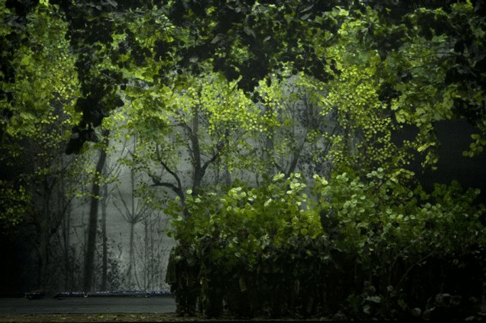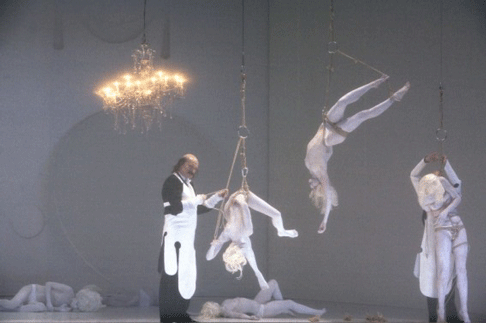Unlike most avant-garde artists Sig. Castellucci has earned mainstream credibility and recognition (France’s major daily newspaper Le Monde named his Divine Comedy cycle the best theatrical event dans le monde for the first decade of the twenty-first century!).
Here in the south of France Sig. Castellucci created one of his eleven-piece cycle La Tragedia Endogonidia for Marseille (each part was created in different cities). We were led, blind, into a black space and left standing, lights illuminated a huge pile of furniture, a brutal action occurred, meanwhile the mess of furniture disappeared and a survivor of the action sat at a piano and played the GymnopÈdie #3 (the one everyone knows). Twenty minutes after we had entered the space we left.
In Brussels it was into the splendor of the ThÈ‚tre Royal de la Monnaie that we entered and some four hours plus later we emerged. What had happened was that a kinetic mess of a forest (trees kept falling) gave way to a brutal action and the survivor then marched to the Holy Grail. And, uhm, that is more or less what happens in Dante’s Divine Comedy too.
While Sig. Castellucci may be stuck in his story telling he is not stuck in the imagery, and that is of course what his art is all about. The Parsifal at the Monnaie was not about Wagner’s Parsifal but about Sig. Castellucci’s art. And that art is considerable and there is no shortage of self congratulation. To wit, Klingsor is a chef d’orchestre, the holy lance is his baton but Parsifal does not catch it because Klingsor lays it on the floor and walks off the stage. Thus in this improvised second act contest between stage and pit Mr. Castellucci seems to be the winner.
Not to mention that for the entire overture a huge image of Nietsche was projected above the orchestra. FYI Nietsche detested Wagner.
Sig. Castellucci’s imagistic language is rife with reference, and like most music the images are not metaphors of ideas or translated spaces but superimpositions of impressions. When examined these vast impressions lead to so many conceptual conclusions that no one may be identified as the absolute. Though it is fun to try.
The first unveiling of the Holy Grail is a clue to Sig. Castellucci’s artistic intuition. A huge white sheet suddenly covered the kinetic forest, thus all motion stopped as we were confronted only with one small, black quotation mark in this void of white — the word of God? As the final vision of the Grail was unfolding Parsifal and the multitudes marched relentlessly forward it (a rolling stage floor allowed the perpetual forward marching). The lights in auditorium were illuminated — we knew that we are not only a part of the multitudes, we were the Grail itself. Well, why not refer this magnificent affirmation of existence to Satie’s insipid ditty.

Too bad for Sig. Castellucci, but the pit won after all. Wagner’s magnetic score received a magnificent reading at the baton of German conductor Hartmut Haenchen who was clearly sympathetic to this reduction of Wagner’s holy rite to visual images — his task was now purely musical rather than dramatic. Never before have such sounds emerged from a pit, the antagonistic guttural attacks of the string bows, shattering fortes, earth shaking fortissimos. Most striking of all innovations were the nymphs of the garden scene placed in the pit which gave the maestro opportunity to transform the sweetness of this music into loud music of inexorable persuasiveness. Mo. Haenchen too abstracted Wagner’s opera.
For all the brilliance of the imagery and the discovery and superlative implementation of a myriad of scenic techniques, for all the visual excitement created by the plasticity (constant movement) of these images and for the intuitive sense of a supra-eternal artistic presence, those four hours seemed long. The slow succession of Sig. Castellucci’s depth images impeded the dramatic flow of Wagner’s opera, visual and musical climaxes seldom coincided.
The casting of young American tenor Andrew Richards was a coup de thÈ‚tre in itself. This neophyte Wagnerian embodied a Parsifal of genuine innocence, and managed its delivery effectively if with far more sweetness than heldentenor brilliance. Because Sig. Castellucci art is visual rather than dramatic the singers rarely had the support of creating and developing character. Thus much of their success was dependent on sheer vocal artistry. The performances of Kundry (Anna Larsson), Amfortas (Thomas Johannes Mayer) and particularly Gurnemanz (Jan-Hendrik Rootering) missed creating sufficient presence. Klingson (TÛmas Tomasson) had much to do — conducting as well as trussing and hanging ballerinas — and thus made a big impression.

The production is huge and magnificent, and, hear/tell, a bit compromised in execution. It is the idealized stuff of the Aix Festival. May it arrive at the Grand ThȂtre de Provence! I would like a second look.
Michael Milenski
Click here for a photo gallery of this production.
image=http://www.operatoday.com/9_Parsifal_26press.gif
image_description=Anna Larsson as Kundry [Photo by Bernd Uhlig courtesy of La Monnaie | De Munt]
product=yes
product_title=Richard Wagner: Parsifal
product_by=Amfortas: Thomas Johannes Mayer: Titurel: Victor von Halem; Gurnemanz:Jan-Hendrik Rootering; Parsifal: Andrew Richards; Klingsor: TÛmas TÛmasson; Kundry: Anna Larsson; Gralsritter: Willem Van der Heyden, Friedemann Rˆhlig. Orchestre symphonique, chœurs et chœur de jeunes de la Monnaie. Direction musicale: Hartmut Haenchen. Mise en scËne: Romeo Castellucci. ChorÈgraphie: Cindy Van Acker. DÈcors, costumes et Èclairages: Romeo Castellucci.
product_id=Above: Anna Larsson as Kundry
All photos by Bernd Uhlig courtesy of La Monnaie | De Munt